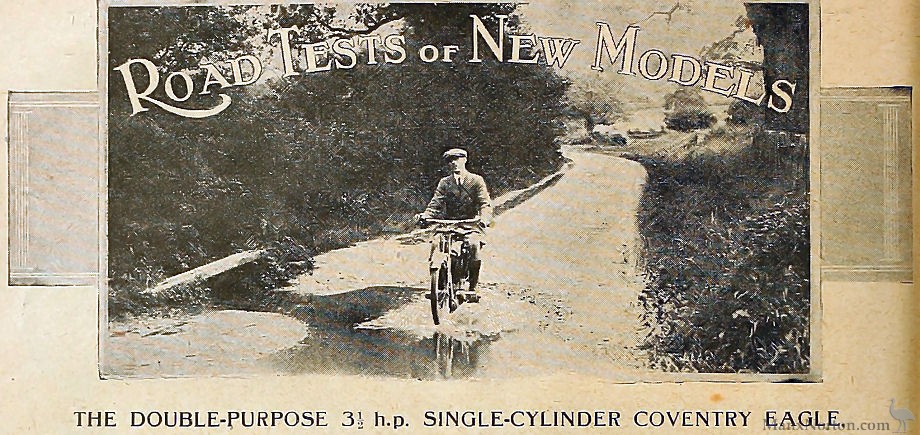



With up-turned bars and footboards, this is a comfortable touring machine. T.T. bars are an alternative fitment.

The 3½ h.p. solo mount, fitted with three-speed King Dick engine and Sturmey-Archer gear box.

The rear suspension system of the Coventry Eagle.
MUCH has been said, from time to time, regarding the demerits of the "single-cylinder," and for years critics have prophesied an early death to this type of engine. The same can be said of the sidecar, and yet by far the most popular passenger outfit on the road to-day is a combination of the two, namely, the dual purpose "single."
It is simple, almost foolproof, and easily handled as a solo mount. At the same time it is sufficiently powerful if suitably geared to haul a sidecar should the owner so desire. Among the well-known manufacturers who build this type of machine is the Coventry Eagle Motor and Cycle Manufacturing Co., and for some years this firm has been marketing a 3½ h.p. model on these lines.
Good Delivery Tune.
Recently we were given an opportunity of testing the 1920 Coventry Eagle on the road. The mount taken over was in no way specially prepared - in fact, it was one of several just assembled, and had not done ten miles on the road. Under these circumstances, it might be thought that a lot of tinkering would be necessary before embarking on a long run. This, however, was not the case, the only alteration being a slight slackening of the gear lever spring to allow it to move more freely.
The machine is of conventional design, incorporating well-known components, and is of pleasing appearance.
The engine is the 3½ h.p. King Dick, made by Abbingdon-Ecco, Ltd., of King Dick spanner fame. It has side-by-side valves, B. and B. carburetter, and E.I.C.. magneto. A short tail pipe is fitted to the silencer, finishing at the gear box. An improvement would be effected by carrying this further to the rear, as the burnt gasses make the kick starter and gear box dirty. The usual chain-cum-belt transmission is used, a Sturmey-Archer three-speed gear box being fitted. The driving chain is enclosed in a substantial aluminium dustproof case.
Aluminium footboards, swept up in front, are fluted, and the rider has, the choice of fiat T.T. or ordinary touring bars.
Well-valanced Mud-guards.
The machine in question was fitted with the latter type, and though we, personally, prefer the flat bar for solo, work, the riding position was found to be very comfortable. Both front and rear mudguards are reasonably wide and well valanced, and although quite a distance was covered over very wet roads, and several water-splashes negotiated, little discomfort was experienced from mud and water.
The first 200 miles were covered principally over main roads, and, as the machine was exceedingly "new," we took things fairly easily in order to allow the engine to get properly "run in."
Later, however, quite an interesting 300 miles run was made in connection with a Western club trial, under conditions which would rarely be encountered in ordinary touring. The course for the most part was over rough stony by-lanes in a hilly district, including a considerable amount of second gear work. The machine behaved excellently, showed no signs of overheating, and was very steady on the rough and greasy surfaces. The engine gave ample power, and on only one occasion was it necessary to use bottom gear; this was on a stiff climb of 1 in 4, where the "change down" was made in order better to negotiate the very bad surface. As regards speed, it can be said that, although no accurate test was made, the 3½ h.p. Coventry Eagle is fast enough to satisfy the average soloist. It is capable of maintaining a good average over long distances without the slightest signs of distress. This was proved on the return journey, when, being without lamps, it was found necessary to cover the last seventy-five miles in under three hours.
Perhaps a better test could have been made had a sidecar been fitted, but, judging by its performance as a solo mount, and from our observations of several we have seen in use with a sidecar, we know that it can truly be described as a dual-purpose mount.
In these days of super-efficient twins riders are apt to overlook the main advantages of the single, viz., its simplicity and lower production costs, which in turn account for its inherent reliability and economy.
The Motor Cycle October 21st, 1920. Pages 464, 465
See also: Coventry Eagle 1920s
If you have a query about Coventry-Eagle motorcycles please contact us